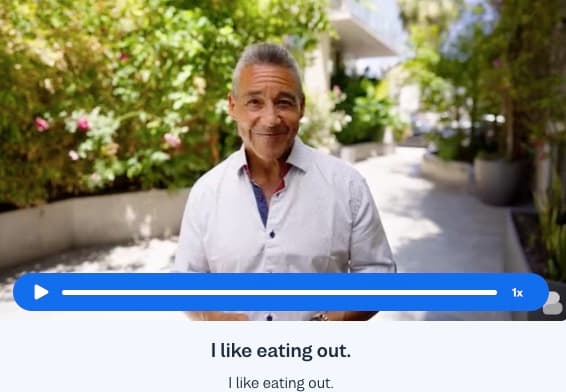I want to learn...
Author:

Chiara Pegoraro
When you speak or listen to English, you don’t have to wait too long before you hear an -ing form, also known as a ‘participle.’
Whether discussing an action that is taking place at this very moment, an interesting characteristic, or the precondition for something to happen, you will use these forms. (By the way, we used two participles in the previous sentence. Can you find the words ending in -ing?)
The -ing form has the grammatical name present participle and has a wide variety of uses. In this article we will see how to form the participle, its most common functions and the most common errors to avoid. Does this sound interesting? Let’s go!
How to form the present participle
Learning the form is a great way to start when talking about present participles. It seems pretty straightforward – you just have to slap on the three magic letters -ing at the end of any verb, and there you go, you have your participle.
While this is true for most cases, there are a few slight variations you need to employ to transform some verbs into participles.
For example, if a verb ends in -c (like panic, frolic and picnic), you will need to add a k to spell the participle correctly, ending up with panicking, frolicking, picnicking.
Also, if a verb ends in a vowel followed by a consonant other than k (for example, run, sit, stop, beg, plan), you double the last consonant to get running, sitting, stopping, begging and planning. This doesn’t have any effect on the pronunciation of the word since English double letters sound the same as single letters, but we need to write these letters nonetheless.
These rules have a few exceptions, because a few verbs end in a consonant that doesn’t double, for example visit, edit, credit and prohibit. This happens because these verbs don’t have the stress on the last syllable, so their participles are spelled visiting, editing, crediting and prohibiting, without doubling the t.
When it comes to words ending in vowels, we also have a few spelling variations. Words ending with -ie add a -y before the -ing, and therefore tie and die become tying and dying. Words ending in -e (not counting words ending with double e) drop the -e and just add the -ing form, so make, take, give and come are spelled making, taking, giving and coming.
This is a lot to take in, so let’s recap all these forms in a simple table.
Spelling the present participle (-ing form)
| Word | ending Verb | Example |
|---|---|---|
| -c | panic, frolic, picnic | I always end up panicking before big exams. |
| vowel + consonant (stress on last syllable) | run, sit, stop, beg | Please, I am begging you! |
| vowel + consonant (stress not on last syllable) | visit, edit, prohibit | We are visiting Scotland next summer. |
| -k | break, cook, look, shriek | I am cooking dinner. |
| -ie | lie, die, tie | I’m tying my shoes |
| -e | make, give, take | I was giving her my feedback. |
| -ee | see, agree, guarantee | We are agreeing on something. |
Now that you know everything about forming the present participle, let’s take a look at several situations when it might come in handy.
How to use the present participle
Present participles are very flexible and can be used in a variety of contexts. They can work as verbs, as adjectives or as nouns. Let’s start with a few examples just to make sure that we all know what we’re talking about.
Present participles as verbs
I can’t talk now. I’m Yesterday I saw you while I was I will be She went outside and started Sipping a cup of tea, John finally started to relax.
All of these examples have a participle that is a verb or part of a verb. The first three sentences use the continuous verb form –I’m eating (present), I was driving (past), and I will be working (future). In all of these cases the action is ongoing or in progress at that specific point in time.
In the case of “She went outside and started jogging,” we have a compound verb, with started marking the beginning of the activity of jogging.
In the last example, we have a participle phrase (sipping a cup of tea), which is a phrase built around the participle that is strongly connected to the following phrase. This is very important – we’ll see why later.
Present participles as adjectives
I woke up to the smell of brewing coffee.
The dancing flames flickered in the fireplace.
This is so interesting!
Anna is amazing! She can do anything!
As you can see from the examples above, the participle is used to give an extra quality that defines an object. You can smell coffee in the morning, but it is an entirely different thing to wake up to the smell of brewing coffee – who doesn't love that?
In the same way, the flames of a fireplace will be dancing, adding that cozy fireplace light that we all love in the winter.
Apart from this usage, the -ing form is very common for adjectives that come from verbs, like interesting from interest, amazing from amaze, and relaxing from relax.
Present participles as nouns
I like swimming.
I enjoy reading in my free time.
Going to bed early is good for your health.
Learning a new language broadens your horizons.
Present participles are a very common way to turn a verb into a noun. You want to talk about the action described by the verb to swim? Just use a participle and your verb will become a noun, ready to be used.
Common mistakes
As we have seen so far, participles are an all-purpose grammar structure. They are easy to form with few exceptions, they serve a wide variety of functions and they can be adapted easily. All in all they are a pretty user-friendly grammar structure.
The only thing you need to pay attention to is the infamous dangling participle, a common mistake that native speakers also sometimes make. The dangling participle (literally a participle that is hanging loose in a sentence) is part of a poorly constructed sentence that is hard to understand.
But what is this tricky mistake? You might have noticed that contrary to most English tenses, participles don’t have a clear subject. To illustrate this, take a look at the following examples:
*I’m going home.
I have been studying this for a long time. * I kept driving for another hour.
In these examples the subject is always I. But take a look at these participial phrases:
Stretching out on my bed, I started to fall asleep.
Driving down the road, I saw a moving van.
Talking to Rami, I realized that I haven’t been on a holiday in years.
In all of these cases, the subject is also I, but it is not explicit in the first part of the sentence. If the sentence was built with two different subjects the result would be very confusing, and that is what a dangling participle is – a verb out of place that is not really connected to the context of the sentence and that is in fact dangling.
Sitting on the porch, the sound of chirping birds filled the air.
Getting ready for the day, the dogs started barking.
Sipping the first coffee of the day, the anticipation of what the day would bring filled me with excitement.
Do you see the problem? The subject of the first sentence should be I, you, or some sort of human being, but the way the sentence is written makes it seem as if the sound of chirping birds was sitting on the porch. In the second sentence, it sounds as if the dogs are getting ready for their day, and in the third sentence it is unclear who is sipping the first coffee of the day.
This is really confusing. Dangling participles can be avoided by carefully phrasing the sentences in a different way.
Sitting on the porch, we enjoyed the sound of chirping birds filling the air.
Getting ready for the day, John heard the dogs barking.
Sipping the first coffee of the day, I was filled with excitement in anticipation of what the day would bring.
Now we have three neat and easy-to-understand sentences using we, John, and I as subjects. What should we learn from this? Never leave the participle dangling around, someone might trip over it!
Want to learn more about forming English sentences? Check out our guide to English sentence structure.
Wrapping up
To review, we’ve seen that present participles are formed by adding-ing at the end of verbs, with slight spelling variations for words ending in specific letters. We’ve looked at how they can be used as verbs, adjectives and nouns, and we’ve discussed potential pitfalls.
Now you know a little bit more about this useful grammar structure, but the best way to master participles is to practice them. Since participles are such a common and useful structure, your English is sure to improve as you spend time using them in communication. So remember – practice your participles, and never leave them dangling around!
AUTHOR

Chiara Pegoraro
Newlanguages


